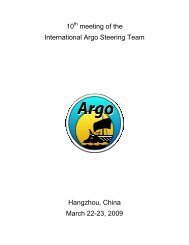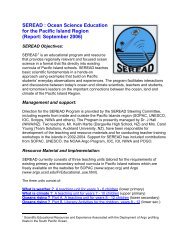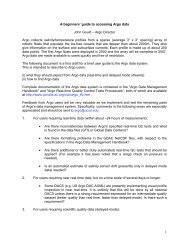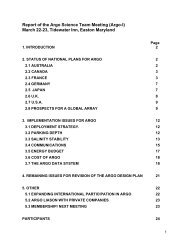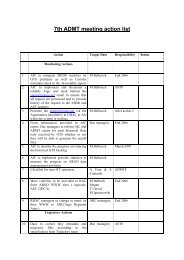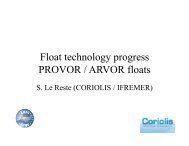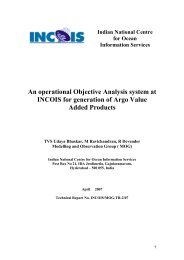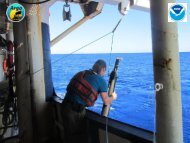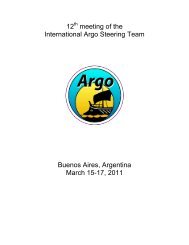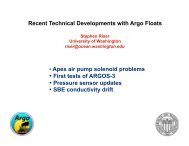11 meeting of the International Argo Steering Team Scripps ...
11 meeting of the International Argo Steering Team Scripps ...
11 meeting of the International Argo Steering Team Scripps ...
Create successful ePaper yourself
Turn your PDF publications into a flip-book with our unique Google optimized e-Paper software.
measurements depend on knowing <strong>the</strong> precise timing <strong>of</strong> <strong>the</strong> <strong>Argo</strong> measurements, and this is<br />
particularly true in <strong>the</strong> upper ocean, where temperature evolve rapidly. In addition science<br />
questions focused on understanding rapidly evolving aspects <strong>of</strong> <strong>the</strong> ocean, such as <strong>the</strong> upper<br />
ocean diurnal cycle, depend on knowing <strong>the</strong> precise timing <strong>of</strong> <strong>the</strong> <strong>Argo</strong> measurements. At<br />
present, different manufacturers have adopted different conventions for defining <strong>the</strong> time when<br />
<strong>Argo</strong> floats rise to <strong>the</strong> surface. Depending on <strong>the</strong> float type <strong>the</strong> best estimate <strong>of</strong> surfacing time<br />
might come from <strong>the</strong> variable JULD, or <strong>the</strong> variable JULD_ASCENT_END, or an adjustment to<br />
one <strong>of</strong> <strong>the</strong>se assuming some knowledge <strong>of</strong> clock drift or time at surface. Brian King reports that<br />
fur<strong>the</strong>r information is available in raw transmission files that are not available to most <strong>Argo</strong> float<br />
users.<br />
Sarah Gille’s recommendations are to set standards for future <strong>Argo</strong> data reporting to make<br />
surface arrival times easier to detect. This could include <strong>the</strong> following:<br />
(1) Establish standard usage for <strong>the</strong> JULD and JULD_ASCENT_END variables for all<br />
data centers.<br />
(2) Have floats report <strong>the</strong>ir internal clock times when <strong>the</strong>y (a) arrive at <strong>the</strong> surface, (b)<br />
begin transmitting, and (c) at <strong>the</strong> moment <strong>of</strong> transmission, or else equivalent information<br />
that would make it possible to have redundant information to determine pr<strong>of</strong>iling times.<br />
(3) Include pr<strong>of</strong>ile times in pr<strong>of</strong>ile files (not just in trajectory files), with information<br />
indicating whe<strong>the</strong>r estimated or exact (or with uncertainties.) If it is not possible to do<br />
this, <strong>the</strong>n establish consistent cycle numbering schemes for trajectory and pr<strong>of</strong>ile files to<br />
allow cross-comparison <strong>of</strong> data.<br />
6.2 Status <strong>of</strong> Bio-<strong>Argo</strong><br />
Bio-optical and chemical sensors on pr<strong>of</strong>iling floats have been used for more than a decade.<br />
They have matured a lot in terms <strong>of</strong> ease <strong>of</strong> integration and robustness with papers describing<br />
<strong>the</strong>m being published in high impact scientific journals. There are currently about 20 pr<strong>of</strong>iling<br />
floats deployed and ano<strong>the</strong>r 150 floats funded that include optical sensors (and about 200<br />
o<strong>the</strong>rs with oxygen and/or nitrate sensor). The <strong>International</strong> Ocean Color Coordinating Group<br />
(IOCCG) has established a committee to provide recommendation on <strong>the</strong> best practices for <strong>the</strong><br />
use <strong>of</strong> optical sensors on pr<strong>of</strong>iling floats (Chair: H. Claustre). A white paper has been written<br />
that will be shared with <strong>the</strong> greater community as soon as it is finalized later this year. In<br />
addition much interest in <strong>the</strong>se technologies has been generated in <strong>the</strong> OceanObs <strong>meeting</strong> in<br />
Venice in 2009 and several manuscripts describing <strong>the</strong> promising future <strong>of</strong> <strong>the</strong>se assets are in<br />
press.<br />
In order to establish a global observatory <strong>of</strong> pr<strong>of</strong>iling floats with biogeochemical sensors it is<br />
imperative that actions be taken soon to standardize sensors, data streams and QC procedures<br />
for both near-real-time and delayed mode. The IOCCG committee has tackled some <strong>of</strong> <strong>the</strong>se<br />
issues and more work is planed soon. Synergies with <strong>Argo</strong> are obvious and would benefit both<br />
communities (increasing funding and user base). In order for this synergy to work, <strong>Argo</strong> will<br />
need to be supplemented with additional personnel (to handle increased data complexity and<br />
volume). Indeed, in France, efforts have been made to find additional funding for <strong>the</strong> Coriolis<br />
data center to deal with <strong>the</strong> added work that will be caused from QC and dissemination <strong>of</strong><br />
biogeochemical data.<br />
19



